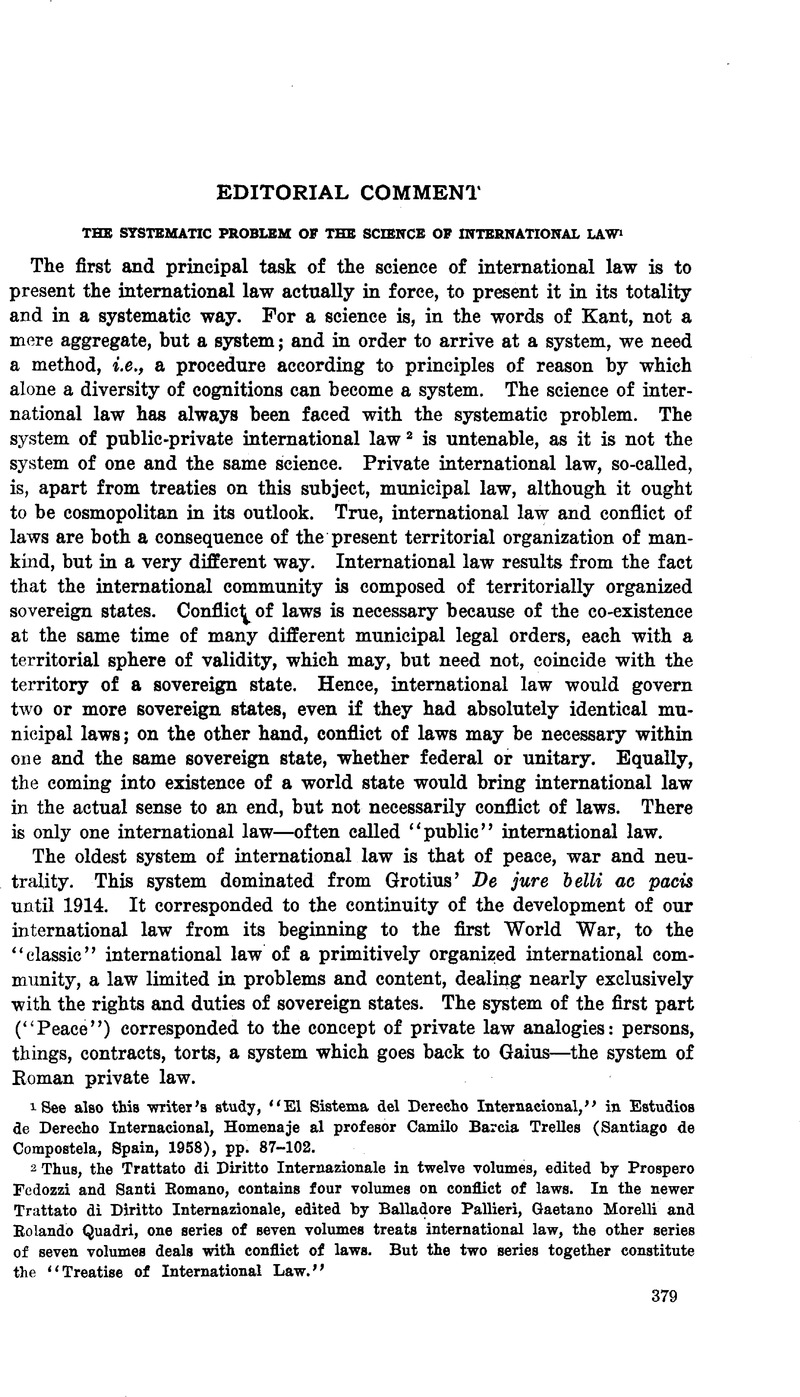No CrossRef data available.
Article contents
The Systematic Problem of the Science of International Law
Published online by Cambridge University Press: 28 March 2017
Abstract

- Type
- Editorial Comment
- Information
- Copyright
- Copyright © American Society of International Law 1959
References
1 See also this writer's study, “ E l Sistema del Derecho International,” in Estudios de Derecho International, Homenaje al profesor Camilo Barcia Trelles (Santiago de Compostela, Spain, 1958), pp. 87-102.
2 Thus, the Trattato di Diritto Internazionale in twelve volumes, edited by Prospero Fodozzi and Santi Romano, contains four volumes on conflict of laws. In the newer Trattato di Diritto Internazionale, edited by Balladore Pallieri, Gaetano Morelli and Bolando Quadri, one series of seven volumes treats international law, the other series of seven volumes deals with conflict of laws. But the two series together constitute the “Treatise of International Law.“
3 Georges Scelle, “Essai de Systématique du Droit International Public,” 30 Eevue Générale de Droit International Public 116-142 (Paris, 1923). See also Manlio Udina, II Diritto Internazionale Tributario 1-15 (Padua, 1949).
4 Thus still, the two-volume work by Marcel Sibert, Traité de Droit International Public (Paris, 1951), is restricted to the “Droit de la Paix.“
5 Thus the leading English treatise by Oppenheim, even in the newest edition by Sir Hersch Lauterpacht, is still based on this system. Also the treatise by Mariano Aguilar Navarro: whereas the first three parts (in seven volumes) will deal with the law of peace, the fourth part will treat the laws of war and neutrality.
6 This system is, e.g., to be found in the treatises by Paul Guggenheim, Traité de Droit International Public, Vol. I (Geneva, 1953), and by Alfred “Verdross, Völkerrecht (3rd ed., Vienna, 1955). See also Josef L. Kunz, “Teoria General del Derecho International,” Academia Interamericana de Derecho Comparado e International, Cursos Monográfieos, Vol. II, pp. 327-444 (Havana, 1955).
7 The only writer who has applied this system completely is Antonio Sánchez de Bustamante y Sirvén, Derecho International Público (5 vols., Havana, 1933-1938).
8 Verdross, Alfred, Die Verfassung der Völkerrechtsgemeinschaft (Vienna, 1926)Google Scholar. See also Georges Scelle, Précis de Droit des Gens, Vol. II : Droit Constitutionnel (Paris, 1934). The second part of the treatise by Mariano Aguilar Navarro (referred to in note 5 above) is entitled: “Constituci6n de la Comunidad Internacional.“
9 Thus, e.g., the second volume of P. Guggenheim's treatise (mentioned in note 6 above, Vol. II, Geneva, 1954); thus also the planned fourth part of A. P. Sereni, Diritto Internazionale. See also Julius Stone, Legal Controls of International Conflict (New York, 1954).
10 See Manlio Udina, II Diritto Internazionale Tributario (Padua, 1949).
11 Jessup, Philip C. recently introduced the concept of an “International Parliamentary Law,” 51 A.J.I.L. 396-402 (1957)Google Scholar.
12 Thus the treatise, edited by Fedozzi and Santi Bomano (referred to in note 2 above) contains, among twelve volumes, one on international administrative law, one on international tributary law, one on international labor law, and even one on international ecclesiastical law.
13 Thus the series dedicated to international law, in the treatise edited by Balladore Pallieri, Morelli and Quadri (referred to in note 2 above), is based on the traditional system: peace—war and neutrality. But whereas the first four volumes will deal with “classic” international law, the fifth is dedicated to “International Organization.” The treatise by Mariano Aguilar Navarro (referred to in note 5 above) is based on the same traditional system. But the second part (in four volumes) deals with general international law, whereas the third part will deal with “Cooperación Internacional y Servicios Internacionales,” i.e., with international organization. This division appears in a different way in the Diritto Internazionale by A. P. Sereni. The second part (in two volumes) is entitled: “ Organizzazione Internazionale.” But that means here the organization of the international community. The first volume, already published, treats “subjects of a territorial character” (states and insurgents recognized as belligerent parties), i.e., general international law. The second volume will deal with “international persons of a functional character,” i.e., primarily with international organisation.
14 Alfred Verdross, Völkerrecht (3rd ed., Vienna, 1955).
15 See Josef L.Kunz, , “Der heutige Stand der Wissenschaft und des Unteirichts des Völkerrechts in den Vereinigten Staaten von Amerika,” 7 Österreichische Zeitschrift für Öffentliches Keeht 401-427 (1956).Google Scholar
16 This impossibility is confirmed by the newest edition of Oppenheim-Lauterpacht, International Law, A Treatise, Vol. I : Peace (8th ed., London, 1956). Sir Hersch Lauterpacht writes that this treatise is primarily dedicated to the presentation of the norms of general international law. But the norms of particular international law not only constantly appear as additions and notes in many places, but the editor has, characteristically, found it necessary to add a large chapter on “International Organization” (Vol. I, pp. 370-450), to treat the International Labor Organization, and to give us a large appendix on international specialized organizations (Vol. I, pp. 977- 1029).
17 See, on these problems, Earl Zemanek, Das Vertragsrecht der Internationalen Organisationen (“Vienna, 1957), reviewed by the writer in 52 A.J.I.L. 565-567 (1958).
18 See, on these problems, Adam, H. T., Les Etablissements Publics Internationaux (Paris, 1957), reviewed by the writer in 51 A.J.I.L. 569-572 (1957).Google Scholar
19 See Georg Erler, , Grundprobleme des Wirtschaftsrechtes (Göttingen, 1956).Google Scholar
20 Jessup, Philip C., Transnational Law (New Haven, 1956).Google Scholar
21 Meron, Theodore, “Eepudiation of Ultra Vires State Contracts and the International Eesponsibility of States,” 6 Int. and Comp. Law Q. 273-289 (1957).CrossRefGoogle Scholar
22 P.C.I.J., 1929, Series A, No. 20.
23 Ibid., No. 21.
24 Verdross, A., “Die Sicherung von ausländischen Privatrechten aus Abkommen zur Wirtsehaftlichen Entwieklung mit Schiedsklauseln,” 18 Zeitschrift fiir auslandisehes öffentliches Eeeht und Völkerrecht 635-651 (1958).Google Scholar
25 Jenks, C. Wilfred, “The Scope of International Law,” 31 Brit. Year Bk. of Int. Law 1-18 (1954).Google Scholar




